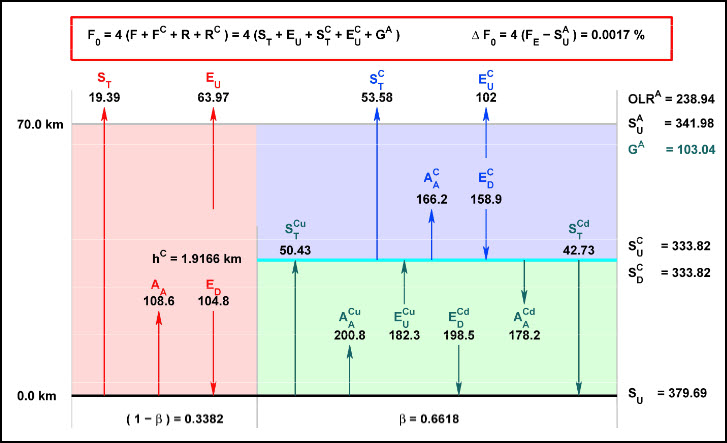Ferenc Miskolczi
Foreign Associate Member of the Hungarian Academy of Sciences
Budapest, Hungary
https://doi.org/10.53234/SCC202304/05
www.scienceofclimatechange.org
History
Ferenc Miskolczi first published his research on this subject in 1989. His following publications (2004, 2007, 2010, 2011, 2014, 2021) led to his 2023 landmark publication shown here.
Ferenc Miskolczi is the first scientist to show how water vapor and clouds control the earth’s radiative equilibrium and counter the radiation effects of non-condensing GHG’s.
Excerpts
The official − Intergovernmental Panel on Climate Change (IPCC) approved − CO2 greenhouse effect hypothesis states that:
- increasing CO2 content of the atmosphere will increase the absorbed upwelling LW radiation from the surface, will reduce the outgoing LW radiation, and will increase the downward LW radiation received by the surface. As a result, the surface will warm up until the top of the atmosphere radiative balance is restored.
Of course, this is not a greenhouse theory but an unproven hypothesis which poses deliberate constraint on the atmospheric response to increased GHG content.
The Earth-atmosphere system is in radiative equilibrium with a theoretical solar constant, and all global mean flux density components satisfy the theoretical expectations.
The IR flux optical depth has no correlation with time and the strong signal of increasing atmospheric CO2 content in any time series is not present in the IR flux optical thickness data.
Consequently, the atmospheric CO2 increase cannot be the reason for global warming.
Atmospheres with condensing GHGs might have several internal boundaries (cloud layers) at different altitudes which instantly disrupt the propagation of the electromagnetic radiation.
Consequently, the global mean cloud cover is the major factor in establishing and maintaining the planetary radiative balance.
In the Earth’s atmosphere (14) shows that the planetary radiative equilibrium cannot be established without involving the cloud cover in the greenhouse problem.
The greenhouse effect predicted by the Arrhenius greenhouse theory is inconsistent with the existence of this radiative equilibrium. Hence, the CO2 greenhouse effect as used in the current global warming hypothesis is impossible.
The greenhouse effect itself and the CO2 greenhouse-effect-based global warming hypothesis is a politically motivated dangerous artifact without any theoretical or empirical footing. Planet Earth obeys the most fundamental laws of radiation physics.
Our planet enjoys the stable climate because the hydrological cycle forces the climate system to maintain the chaotic upper tropospheric humidity and wind field, the equilibrium cloud cover and precipitation, and moves the latent heat among the different geological reservoirs ‒ as required by the planetary energetics.
The role of the non-condensing GHGs stems from the fact that they do not participate in the hydrological cycle, they cannot contribute to the entropy production, but they can regulate the transmitted flux density to the level required by the Milne-Eddington equations.
Any perturbations to the flux optical thickness by non-condensing GHGs will force the hydrological cycle to restore the theoretical equilibrium state.
Climate modelers generally assume a hypothetical positive feedback process which amplifies the initial warming: higher surface and atmospheric temperatures will increase the water vapor content of the atmosphere, and the increased water vapor absorption will further increase the warming effect.
The unphysical assumption of positive feedback (known as the Simpson paradox) stems from the Schwarzschild solution of the RE state in stellar atmospheres, which predicts unconstrained temperature growth with increasing optical depth.
The Schwarzschild solution also predicts a large (never observed) surface temperature jump at the lower boundary, and at the small optical thickness limit it violates the law of conservation of radiant energy (an airless planet should have a surface radiative temperature equal to the temperature of the APS).
The most valuable result of this research is the theoretical foundation of the observed radiative structure of the Earth’s atmosphere.
In the Earth’s atmosphere the theoretical equilibrium optical thickness is the natural constraint on the equilibrium mass of the WV in the atmosphere.
Let us emphasize the overall conclusion: The Arrhenius type greenhouse effect of the CO2 and other non-condensing GHGs is an incorrect hypothesis and the CO2 greenhouse effect based global warming hypothesis is also an artifact without any theoretical or empirical footing.


After I volunteered for the unpaid job of Expert Reviewer for the manuscript for IPCC AR6 (the latest version of the IPCC’s Climate Assessment Report), the IPCC reviewed my record of peer-reviewed publications in the literature of global warming climatology and on this basis accepted my offer. When I read the manuscript I noticed that it overlooked a glaring error in the argument made by an IPCC climate model. This was that the runs of such a model conveyed nil infomation gain to a would-be regulator of the outcomes of the events of the future for Earth’s climate system, precluding regulation of this system by a would-be regulator of it. On these grounds, I advised against the publication of this manuscript. Without addressing the issue I had raised, the IPCC ignored me and published the faulty manuscript. My appeals to the Chair of the IPCC and Chief Statistician of the United Nations were to no avail.
Pingback: Energy and Environmental Review: September 25, 2023 - Master Resource
Pingback: AWED MEDIA BALANCED NEWS: We cover COVID to Climate, as well as Energy to Elections. - Dr. Rich Swier